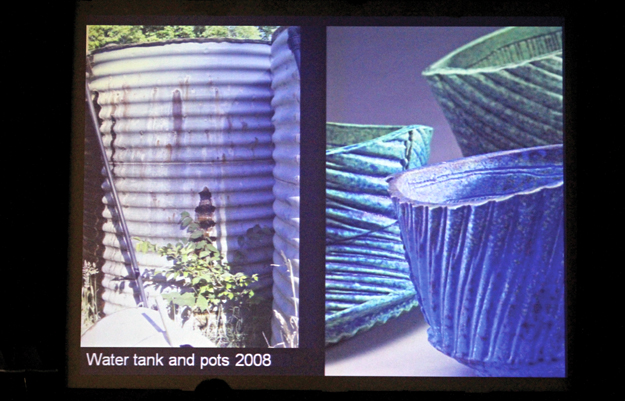Clik here to view.

Ceramics is a down to earth art form. The opening day of the seminar for the Fourth ASNA Clay Triennial only cemented this notion, beyond its obvious connotation, when visiting ceramists spoke about their art work at the VM Rangoonwalla Center.
“20 years ago, it was important for me to say that I made these things,” said Norwegian potter John Skognes. “But now it isn’t. I just make things happen.”
Heavily inspired by nature, and completely in sync with traditions of the native people of Norway, Skognes seems to have risen out of the beat culture. During his presentation, he kept the audience in a trance through the visuals he offered and the narrative each represented.
Image may be NSFW.
Clik here to view.
The beauty of Skognes’ ceramics lies in their simplicity, as he uses salt glaze, clay and wood fire as the mediums for his creation. At the seminar, Skognes spoke about the connection between his pottery and the environment in which he dwells.
Taking refuge in Norway’s mountain regions, Skognes lives in a sparsely populated area, with the company of his potter friends and daughter. His artwork gains much from this landscape.
At the very beginning of the presentation, he showed a picture of a snow capped mountain, blanketed under the starry night sky.
“This was the day Ronald Reagan was elected as president, a sad day for some,” he said in his soothing voice, proceeding to show a picture of an art piece where he captured the landscape.
The small act showed how the artist’s works encapsulates his physical, political and natural surroundings, and that these themes aren’t just restricted to his paintings. Each of Skognes’ pottery pieces also have a story to tell.
“I was using a lot of ‘slips’ at first,” he said, by which he meant that his pottery came into being by a series of trials and errors. Skognes’ most fascinating work is a kettle with the handle of a juniper. His hand-made creations take one back to the very basics of mankind. But a dismayed Skognes told the audience how most people cannot relate to these traditions and the role commercialisation of ceramics has played in their dwindling appreciation.
“In Norway, people used to make objects from their hand. Now, craftsmanship is a language few can relate to,” he said.
Skognes draws parallels between his life and work to that of the indigenous Sami people.
“The Samis make a huge fire out of dry bushes, and when it dies down, they pack they pack the ashes very tightly and sleep on it. But this can be dangerous, obviously, as a single remaining ember can spark a huge fire once more, so they tie their dogs to their foot. So if in case, there is a fire, the dog can pull them away,” he said. “Sometimes, I think, clay was my dog.”
Image may be NSFW.
Clik here to view.
Visiting artists say landscape and surroundings influence their work. PHOTO: AYESHA MIR/EXPRESS
Skognes’ humility, coupled with Australian ceramist, Merran Esson’s fascination with the tactility of the work, strengthens how these artists are so deeply connected to their environment.
Esson, who is the chairperson of the department of ceramics at Australia’s National School of Art, finds relationships between man-made things and natural things.
“Ceramics is easy; we are taking a soft material and firing in a kiln until its hard…much like how a volcano forms rocks,” she said.
Her container-like ceramics are the collision of the childhood she spent at a farm and the Broken Hill desert, where she studied natural landscape and incorporated them into her works.
The Collision is one of Esson’s ceramics, which demonstrates the similarity between water gushing down hills, quite similar to the way they do in tanks.
“[It shows] what human beings are doing and what nature is doing,” she said.
Esson’s rotund ceramic structures, that have metallic surfaces, define her work.
“Finding you own subject matter is important,” Esson said. “It’s better to whisper in your own voice than to shout in someone else’s.”
It’s this proximity with nature, personal experience, history, politics and just working with earth that gives ceramics a multitude of voices, embroiled in the functionality of seemingly simple clay pots.
Published in The Express Tribune, January 15th, 2013.
Like Life & Style on Facebook for the latest in fashion, gossip and entertainment.